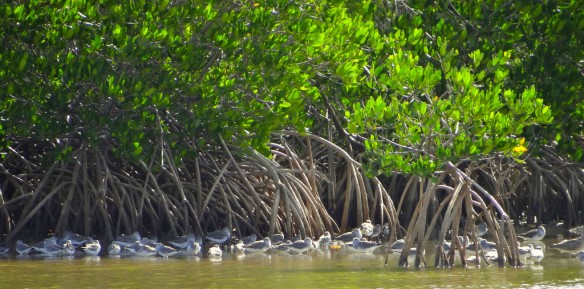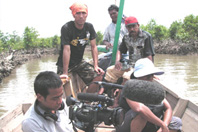
Photo source: ©© Barloventomagico
The Greenbelt Reports (GBR) is a multi-media, Asian regional educational project to document the conservation challenges involving mangroves, coral reefs and sand reefs – collectively called ‘greenbelts’ in recognition of their natural protective role against wave action and anticipated climate change impact.
In mid 2005, TVE Asia Pacific launched this regional project is to journalistically investigate and report on efforts to balance conservation needs of coastal greenbelts with socio-economic needs of coastal communities. It was one of TVEAP’s communications responses to the Asian tsunami of December 2004.
‘Green Coast – for nature and people after the tsunami’ was itself formulated by four international organisations in response to urgent pleas from Asian partners to help recover damaged coastal ecosystems and influence better coastal resource management policies.
Filming The Greenbelt Reports in Jaring Halus, Indonesia 2006The founding partners of Green Coast are Wetlands International, World Wide Fund for Nature, IUCN and the Dutch environmental network Both Ends.
The Green Coast project is being financed for 18 months by Oxfam Novib, through Dutch public charity funds. Oxfam Novib is a member of Oxfam International, and has been one of the longest European partners and supporters of TVE Asia Pacific.
The Greenbelt Reports is a project that involves the production of new, journalistic material and their active distribution through broadcast, educational and civil society outlets across the Asia Pacific. Emphasis will be on coastal countries, especially those that were affected by the Asian Tsunami.
The Greenbelt Reports first series comprises one half hour regional documentary and 12 self-contained short videos 5 minutes in duration. Each tells the story of a community, activist group or researchers engaged in saving, restoring or regenerating coastal greenbelts.
Stories in the first series, to be released in December 2006, have from coastal areas in India, Indonesia, Sri Lanka and Thailand – the four countries that were hardest hit by the Tsunami.
“This series is not about the Asian Tsunami, but was inspired by the mega-disaster,” says Nalaka Gunawardene, Director of TVEAP and executive producer of The Greenbelt Reports. “This is an attempt to capture one of the key environmental lessons of the Tsunami, which we need to amplify as much as possible.”
Green Coast has supported the filming of stories on mangroves, coral reefs and sand dunes in four different locations in the north-western, southern and eastern coastal areas of Sri Lanka (see box for synopses).
These were produced in cooperation with the following local level conservation groups or community organizations: Nature Conservation Group, Neo Synthesis Research Centre, Turtle Conservation Project and the community of Paanama village, eastern Sri Lanka.
Using funding support from the Green Coast project, the Sri Lanka stories – as well as the regional overview documentary, Greenbelt Reports: Armed by Nature — will be versioned into Sinhala and Tamil. These will then be distributed through national broadcasts, and at a dozen public outreach events to be organized in coastal locations.
The public outreach events are being scheduled for December 2006, which will also mark the second anniversary of the Asian Tsunami.
The Sri Lankan coast was one of the most heavily damaged areas in the region following the tsunami of December 26th. Sri Lanka suffered the highest number of deaths after Indonesia, an estimated 34,000 people on the island lost their lives and thousands more are missing. The number of homeless people was estimated at about 800,000 while about 400,000 are said to have lost their livelihoods – primarily in agriculture and fishery. The tsunami caused severe damage in 12 of the country’s 14 coastal districts.









